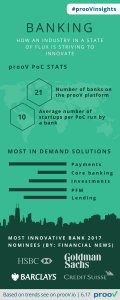
When one thinks about innovation, futuristic hoverboards and holograms usually come to mind. Yes, innovation is what drives the creation of out-of-this-world devices and concepts that are often portrayed in movies, but it is also shaping our world on a more tangible, daily basis.
From our commute to work to making a cashless payment to pay for lunch, innovation is impacting processes and industries, and quickly at that. One of the industries that is being innovated at a sure-fire pace and showing no signs of slowing down is banking, and this is evident on the prooV platform.
Innovative Banking and prooV
Being a platform that helps enterprises innovate, we have the eyes on companies taking their digital transformations strategies seriously, as well as the solutions they seek.
Currently, there are 21 banks utilizing prooV to find and test innovations. How do they do this? They do this by joining prooV, opening PoC opportunities, accepting startups eager to join the PoC and prove their solution and moving forward post a successful PoC (if desired by both parties).
Some of the banking related PoCs currently running on prooV include:
- Point of Sale Financing
- Cyber Security for Financial Organizations
- Supply Chain Finance and Blockchain
- and more…
In our June 2017 #prooVinsights (image below) we shared stats about the evolving banking industry, as seen on our platform.
Evolving Banking Categories
As made clear by the bar diagram on the #prooVinsights infographic, most in demand solutions within banking vary. The solutions are explained below from most in demand to least.
Payments
A payments system is used by banks and financial institutions to make financial transactions and is the fastest-moving solution in terms of innovation. Payment systems are all-encompassing and include the people, procedures, institutions, and technologies that are used to make the exchanges possible.
The consumer and retail payment sectors are quickly changing due to the FinTech startups that have ventured into the space in recent years, leveraging new technologies that shake up traditional practices. New solutions allow for faster speeds and increased efficiency, as well as more flexibility with where and when they’re made. The most significant innovations are bringing change to retail payments, as eCommerce trends continue to skyrocket, requiring digital and real-time payments.
PFM
PFM (Personal Financial Management) is software offered by banks to help users manage their finances by displaying the amount spent on various things such as travel, groceries, shopping, restaurants, and more in one interface.
In PFM software, expenses are logged by categorizing transactions and then organizing them into a view that is easy for users to understand. The software displays data-heavy visualizations for spending trends, budgets and net worth – think pie charts, bar graphs, and other representations. It is for this reason that innovative solutions for PFM software require data aggregation (Big Data) and organization technologies and the FinTech startups are ready to answer those calls.
Lending
More commonly known as a loan, lending is the giving of money from one individual or organization to another. Banks and other financial institutions are often the providers of loans and are constantly seeking new solutions to innovate the transaction itself and the process as a whole.
Bank clients desire more customer-friendly lending solutions, ones that cut down the time spent filling out paperwork and completing the process in local branches. Online solutions, which allow users to apply and receive a loan from their phone or computer whenever and from wherever are not only wanted, but needed. These data-driven online processes will also cut down loan approval times to days or, in some cases, minutes.
Investments
Investment banks provide different services than traditional consumer-banks by assisting individuals or businesses manage wealth through trading and/or asset management.
Technologies in the investment space are innovating how risks are calculated and managed and the way reporting is done. New technologies that can foresee market trends and adapt accordingly are crucial to helping firms deliver the best services to their clients and stay at the brink of innovation.
Core Banking
A core banking system is used to support a bank’s most common transactions such as opening new accounts, processing payments, deposits, and withdrawals, maintaining records for all the bank’s transactions and more.
Current processes are old and outdated, requiring manual automation and person-to-person interactions. New systems are beginning to change all this by offering a more automated and hands-off approach such as banks without human tellers, saving banks money while still offering their clients the best services.
Banking for Success
It is no doubt the banking industry is undergoing major changes, making it crucial for banks and financial institutions to be attuned to the needs of their clients. By taking a look at the needs and evolving banking categories, we hope this dig-down into the industry in flux will both enlighten financial industry executives and encourage FinTechs to push forward and innovate.